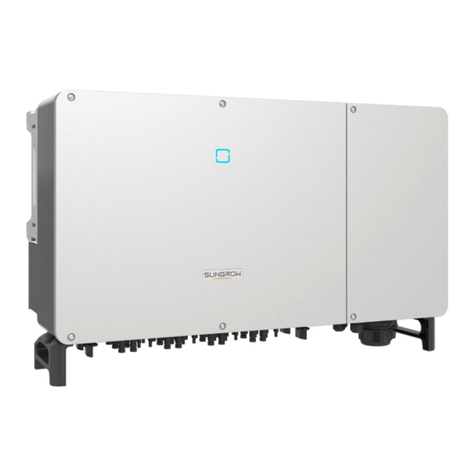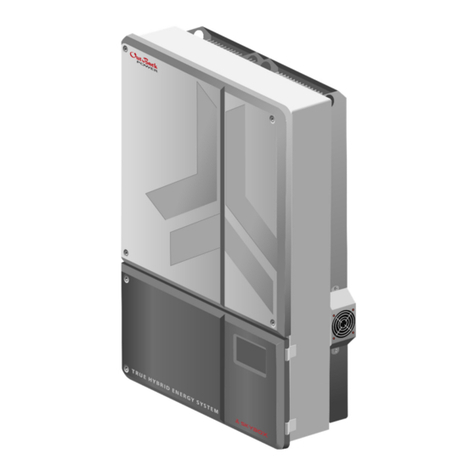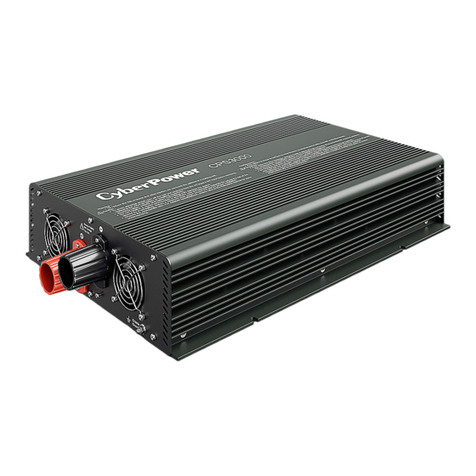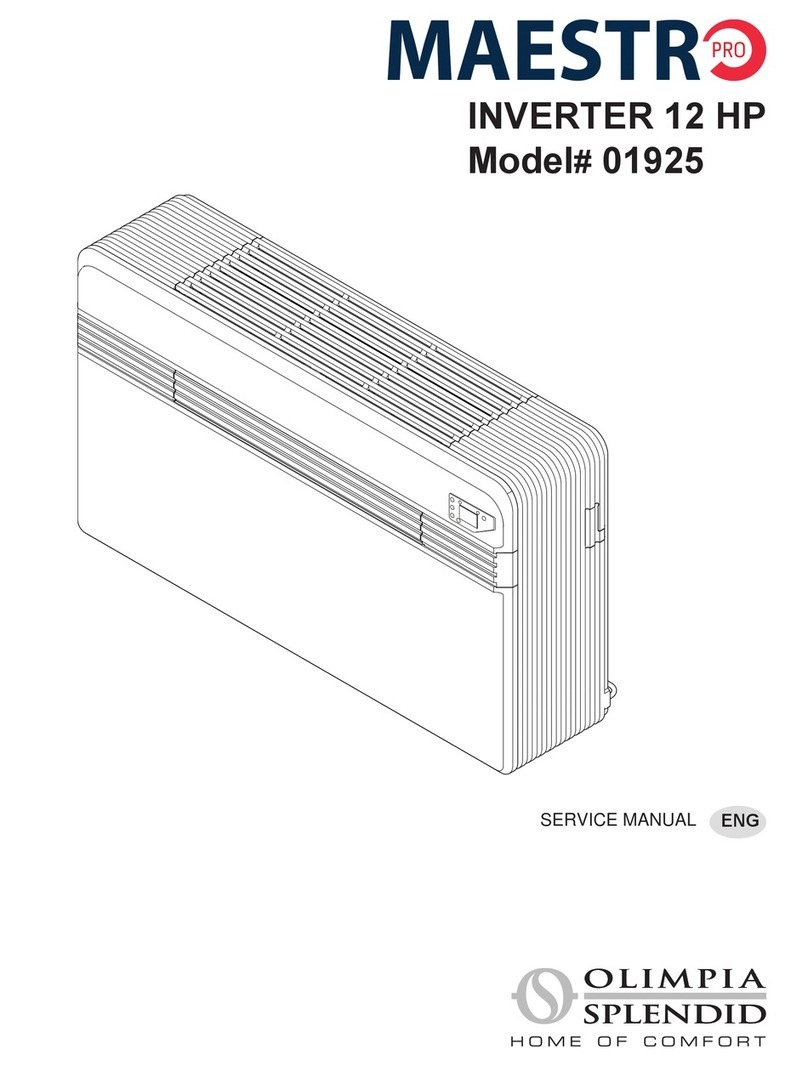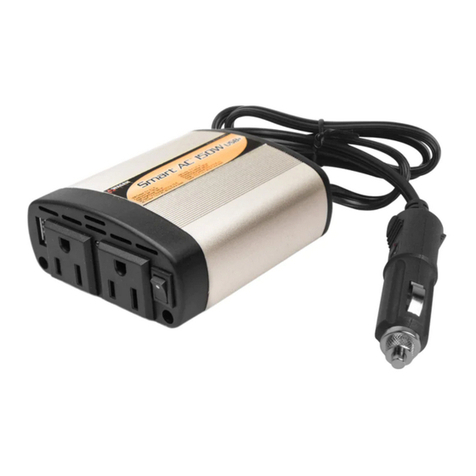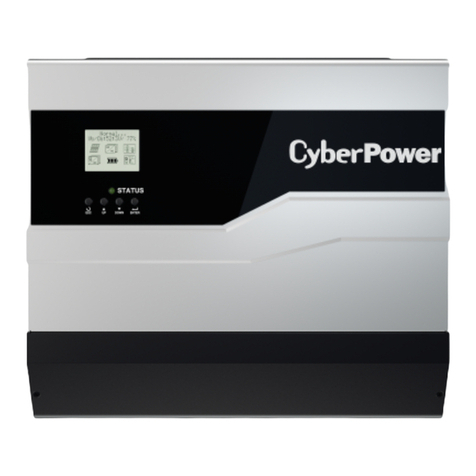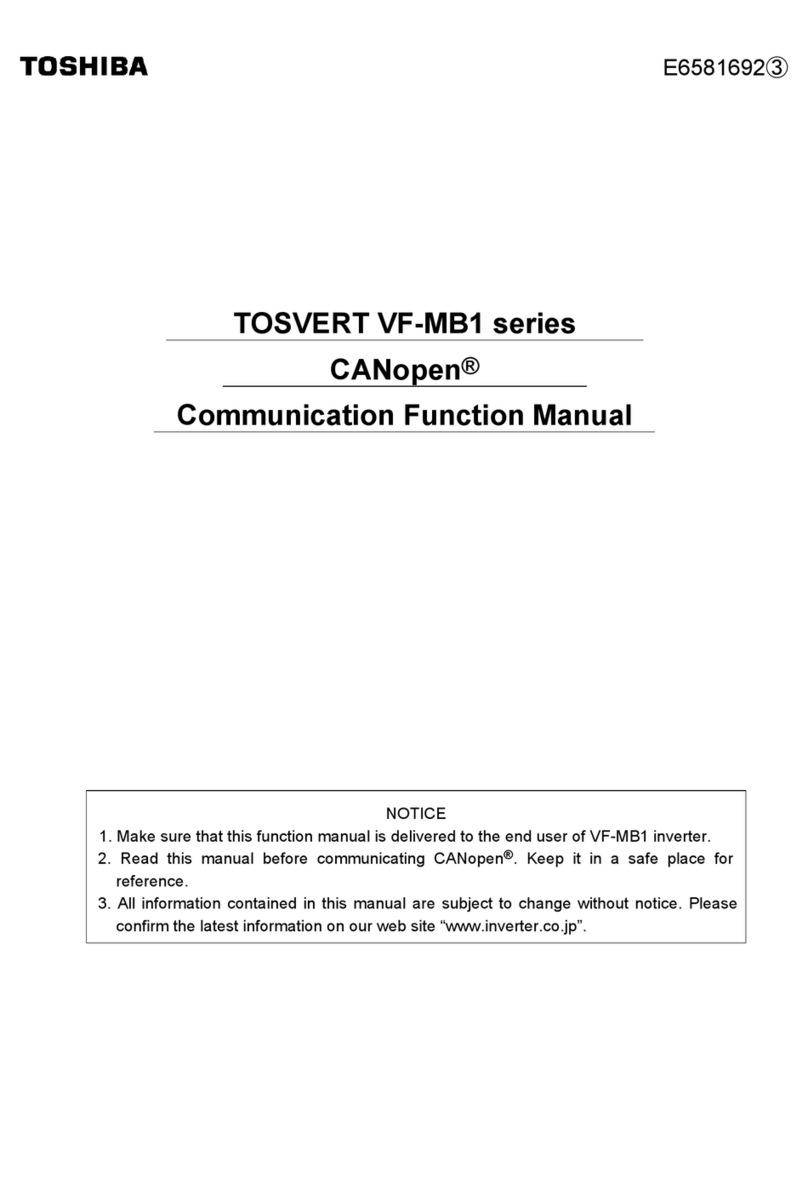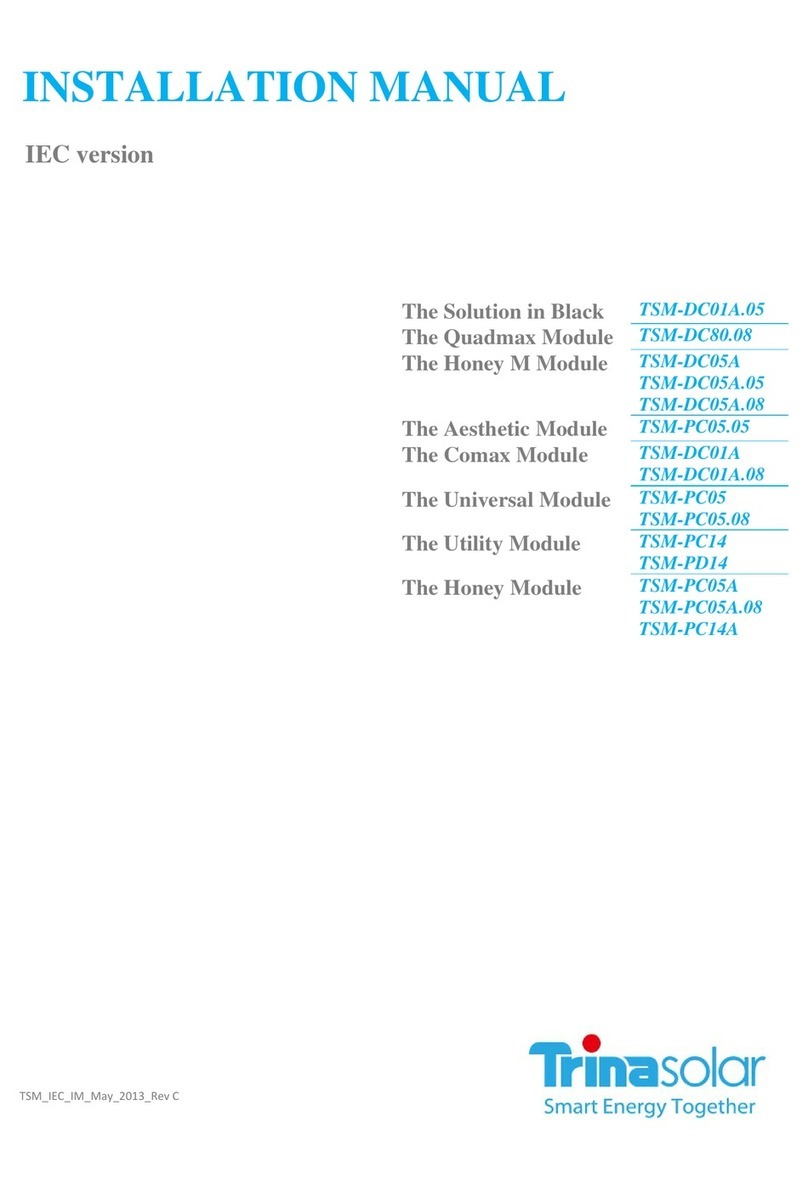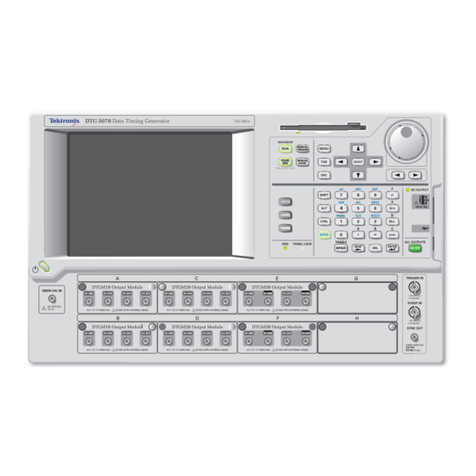Novatech Instruments 409B User manual

NOVATECH INSTRUMENTS 1409B Manual
INSTRUMENTS
INSTRUCTION MANUAL
Model 409B, 171 MHz, 4-Channel Signal Generator
Model 409B
Table of Contents
Section Page Contents
12Description
22Specifications
33Hardware Installation
- 5Table 3, Serial Commands
46Operating Instructions
59Theory of Operation
610 Performance Test
711 Calibration
812 Option /R
913 Option –AC
10 14 Option /W
—16 Warranty

NOVATECH INSTRUMENTS 2409B Manual
NOTE:
This manual applies to Model 409B with Firmware ver-
sion 2.1 or later.
1.0 DESCRIPTION
1.1 The Model 409B is a four-channel Direct Digital
Synthesized (DDS) Signal Generator in a small table
top case with RS232 serial control. The 409B provides
four independent, phase-synchronous sine wave output
signals, which can be set from 0.0 Hz (DC) to 171 MHz
in 0.1 Hz steps when using the internal VCTCXO clock.
(Consult factory if LVCMOS signals are desired.)
1.2 The 409B can also be used with an external clock
input. An on-board programmable frequency multiplier
generates the system clock allowing user configured fre-
quency ranges. The multiplier can be disabled for direct
inputs up to 500 MHz for optimum phase noise perfor-
mance. When used with the same external clock source,
multiple 409B are phase synchronous.
1.3 A Table Mode feature enables users to store frequen-
cy, phase, amplitude and dwell time settings in static
RAM. The 409B can then run through the table automat-
ically, step through it on command from the serial port or
from an external hardware trigger.
1.4 The /R option converts the External Clock input to a
10.00 MHz reference input. This option allows locking
to and tracking an external 10.00 MHz reference, with no
binary round-offer errors. When this option is installed
the accuracy and stability of the output are equal to those
of the reference.
1.5 The –AC option adds two SMA connectors on the
rear panel and enables synchronization of frequency,
phase and amplitude updates with external devices using
user provided hardware trigger signals.
1.6 The /W option provides a wireless connection be-
tween the 409B and a computer or tablet. It includes two
dongles. One plugs into and is powered by the 409B and
the other plugs into and is powered by the USB port on a
customers computer.
2.0 SPECIFICATIONS
2.1 OUTPUTS
TYPES: Four sine simultaneously (four independent,
phase-synchronous outputs).
IMPEDANCE: Sine: 50Ω; LVCMOS: 50Ω.
RANGE: 0.0 Hz to 171 MHz in 0.1 Hz steps (Sine out,
int. clock).
SINE AMPLITUDE: approximately 1Vpp (+4dBm) into
50Ω. Programmable from 0/1024 to 1023/1024 of Full
Scale (10-bits), or by scale factors of 1/2, 1/4, or 1/8.
PHASE: Each channel 14-bits programmable (0.022o).
FLATNESS: ±3dB from 1 kHz to 150 MHz referenced
to amplitude at 35 MHz, full scale.
2.2 LVCMOS
Voh >=2.4V and Vol <=0.4V when series terminated.
Rise and fall times <1.5ns (>1 MHz, <125 MHz). Ap-
plies for LVCMOS Signal Outputs. Also applies for Op-
tion –AC IOUD and TS Trigger Inputs and Outputs.
(Consult factory for LVCMOS Signal Outputs)
2.3 CONTROL
Output frequencies, amplitudes (10-bits) and phases (14-
bits) are controlled by an RS232 serial port at 19.2kbaud.
All settings (except table mode data) can be saved in non
-volatile (EEPROM) memory via the RS232 port.
2.4 ACCURACY AND STABILITY
Accuracy: <±1.5ppm at 10 to 40oC. Stable to an addi-
tional ±1ppm per year, 18 to 28oC. (Internal Clock)
2.5 EXTERNAL CLOCK IN
LEVEL: 0.2 to 0.5 Vrms sine or square wave. 50Ω.
FREQUENCY: 10 MHz to 125 MHz with multiplier of 4
to 20 enabled. Direct input of 1 MHz to 500 MHz.
2.6 EXTERNAL REFERENCE (/R OPTION): Exter-
nal Reference must be 10.00 MHz, ±5ppm. Automatical-
ly detected. Internal clock is locked to and tracks this
value.

NOVATECH INSTRUMENTS 3409B Manual
2.7 SPECTRAL PURITY
(Typ. 50Ω load, internal clock, full-scale output
Phase Noise: <-120dBc, 10 kHz offset, 10 MHz out.
Spurious:
<-60dBc below 10 MHz (typ. 300MHz span)
<-60dBc below 40 MHz
<-55dBc below 80 MHz
<-50dBc below 160 MHz
Harmonic:
<-65dBc below 1 MHz
<-55dBc below 20 MHz
<-45dBc below 80 MHz
<-35dBc below 160 MHz
(channel-channel isolation: <-60dBc)
2.8 TABLE MODE
On-board 4Mb static ram holds up to 32,768 profile
points allowing a different output in 100μs increments.
2.9 POWER REQUIREMENTS
+4.5 to +5.5 VDC <1Amp. AC adapter provided.
2.10 SIZE
39mm H, 107mm W, 172mm L, not including connect-
ors.
2.11 CONNECTORS
BNC for Sine Outputs and EXT CLK IN. DE9 for Serial
Control. 2.5mm center positive power receptacle for +5
volts input. AC-adapter provided.
2.12 OPTIONS
OPTION /R: Changes the external clock input into a
10.00 MHz only, external input. The internal VCTCXO
oscillator is phase locked to this customer supplied exter-
nal 10MHz clock.
OPTION -AC: Adds IOUD and TS SMA connectors on
rear panel for external control of output signal update
timing. 3.3Vdc Logic pulled up via 3.3K Ohm internal
resistor.
OPTION /W: Provides wireless serial communication.
Uses FTDI chip set and virtual COM port.
3.0 HARDWARE INSTALLATION
3.1 Power Connection. The required power of +5Volts
DC is applied through a 2.5mm center-positive power
connector (Switchcraft 712A or equal). The supplied AC
adapter comes with the correct mating connector.
WARNING:
Use of an unregulated source may damage the 409B.
Use only the provided AC-adapter or consult Novatech
Instruments for application assistance if you wish to use
another power source.
3.2 Power Supply. The quality of your power supply
affects the performance of the 409B. The supply should
be free of ripple and noise (<50mV). Even though exten-
sive filtering is used internal to the 409B, a quiet and
well regulated power supply will ensure optimum perfor-
mance. The supplied AC-adapter has been tested for
proper operation.
3.3 RS232 Serial Interface Installation. The 409B is
controlled by sending commands from a computer using
the RS232 Serial Interface. See Table 3 for a complete
set of commands. To send commands, connect your host
computer to the 9-pin female RS232 connector on the
rear panel of the 409B. If you are using a PC having an
RS232 Serial port, a 9-pin monitor extension cable used
as an RS232 cable will allow direct connection to the
409B without the use of a null modem cable or gender
changer.
3.4 RS232 DE9 Connector Pinouts. The data TO the
409B is on pin 3; the data FROM the 409B is on pin 2
and the COMMON return is on pin 5. If Option /W is
installed then 5Vdc is on pin 9.
3.5 COM Port Settings. Default 409B settings are 19.2
kBaud, 8 bits, 1 stop bit, no parity and no hardware flow
control.
NOTE:
The SOF8_409 Software Program is supplied on a CD
with the 409B. This program provides a graphical inter-
face , enabling simplified control of the 409B.

NOVATECH INSTRUMENTS 4409B Manual
3.6 USB Interface. A USB to RS232 adapter cable is
available for use with computers that do not provide a
serial port. Follow the manufacturer’s installation in-
structions when using a USB adapter.
3.7 Serial Commands. Commands are not case sensi-
tive. There must be a space after each command except
R, CLR, S and QUE commands. Commands must end
with any combination of Carriage Return (CR), Line
Feed (LF) or CRLF. Illegal commands will result in an
error code being returned per Table 1. Table 3 on the
next page lists the serial commands.
3.8 Query Command. The “QUE” command returns
five hexadecimal strings reflecting the present state of
the 409B. See Table 2 for an explanation of the values
that make up these strings.
3.9 Internal Clock. If you plan to use the 409B internal
clock, which is the default setup mode, no action is re-
quired. If the 409B was previously set to use the external
clock, send the serial command “C i” to reselect the in-
ternal clock. If you wish to maintain this setting, use the
save command “S”.
3.10 External Clock. If you are providing your own ex-
ternal clock source, configure the 409B by sending the
serial command “C e”. Next set the system clock fre-
quency (up to 500MHz) by sending the “Kp aa” com-
mand with your desired clock multiplier. The system
clock frequency is your external clock frequency times
the clock multiplier. Finally, apply your external clock
to the external clock input BNC on the rear panel. Note
that phase noise and stability are dependent upon your
supplied clock. See specifications for signal levels re-
quired and acceptable frequency range. If you wish to
maintain this setting, use the save command “S”.
CAUTION:
If the system clock frequency exceeds 500 MHz, you may
overheat and damage the 409B.
Error Code Meaning
OK Good Command Received
?0 Unrecognized Command
?1 Bad Frequency
?2 Bad AM Command
?3 Input Line too Long
?4 Bad Phase
?5 Bad Time
?6 Bad Mode
?7 Bad Amp
?8 Bad Constant
?f Bad Byte
Table 1: RS232 Error Codes
05F5E100 0000 03FF 0000 00000000 00000000 000301
05F5E100 1000 03FF 0000 00000000 00000000 000301
05F5E100 0000 03FF 0000 00000000 00000000 000301
05F5E100 1000 03FF 0000 00000000 00000000 000301
80 BC0000 0000 6102 21
Descripon (All values above are in hexadecimal):
The lines above describe current sengs for the four
output channel numbers 0,1,2 and 3 in sequence.
For example, Channel 0 values are:
“05F5E100” = frequency in 0.1Hz steps per LSB
(10MHz);
“0000” = phase seng (0);
“03FF” = amplitude seng(1023).
The last four groups of hex values on the rst four lines
and the enre last line describe AD9959 and microcon-
troller register sengs for use by the factory. The last
two digits on the last line provides the 409B rmware
revision number, in this case rev 2.1.
Table 2. Response Example for QUE Command

NOVATECH INSTRUMENTS 5409B Manual
RS232 Command Function
Fn xxx.xxxxxxx Set Frequency of output “n” in MHz to nearest 0.1Hz. n=0, 1, 2, 3. Decimal point required.
0.00 sets a channel to DC. Maximum setting: 171.1276031 MHz. Single tone mode.
Pn N Set Phase. N is an integer from 0 to 16383. Phase is set to N*360o/16384 or N*/8192 radi-
ans. Sets the relative phase of the frequency output depending upon the value of n=0, 1, 2, 3.
Single tone mode.
E x Serial echo control. x=D for Echo Disable, x=E for Echo Enable
C x Select clock source. x=E for External clock, x=I for Internal Clock. May require adjustment
of Kp and external filtering of output. (Do not use this command if the /R option is chosen.)
R Reset. This command resets the 409B. EEPROM data is preserved and, if valid, is used upon
restart. This is the same as cycling power.
CLR Clear. This command clears the EEPROM valid flag and restores all factory default values.
A x x=E for LVCMOS Enable, x=D for LVCMOS Disable. (Consult factory for LVCMOS.)
S Saves current state into EEPROM and sets valid flag. State used as default upon next power
up or reset. Use the “CLR” command to return to default values.
QUE Return present frequency, phase and status. Returns a character string of all internal settings.
M N Mode command. N= 0 puts the 409B into single tone on all channels (default). N=t puts the
409B into Table Mode for channels 0 and 1. N=a and N=n control when the phase register is
cleared (see paragraph 4.12)
Vn N Set voltage level of output. In default, the amplitude is set to the maximum: approximately
1Vpp (+4dBm) into 50Ω. N can range from 0 (off) to 1023 (no decimal point allowed). Volt-
age level is scaled by N/1023. n=0, 1, 2, 3 to set the amplitude on frequency 0, 1, 2 or 3. If N
>=1024, the scaling is turned off and the selected output is set to full scale.
Vs N Set the output amplitude scaling factor. N=1 for full scale, N=2 for one half scale, N=4 for
one quarter scale and N=8 for one eighth scale. All channels are scaled equally.
Kp aa Set PLL reference multiplier constant. Must be one Hexadecimal byte as two characters. Le-
gal values are 1 (bypass PLL) and 4 to 20 (01, 04 to 14). Values of Kp times clock frequency
must not be between 160 MHz and 255 MHz (for internal clock, this disallows 5<=Kp<= 9).
TS Table Step command. If the M t command is set, TS causes the 409B to step through the ta-
ble. Requires all dwell settings to be “ff”. The TS command can also be executed by a nega-
tive edge on the rear mounted TS control input. (Option -AC adds the TS control input.)
Dn aaaa Read table values. n = output channel 0 or 1. aaaa = table address.
I x Set the I/O update pulse method. If x=a, then an I/O update is issued at the end of each serial
command (default). If x=m, then a manual I/O update pulse is sent by a subsequent ‘I p’ com-
mand. If x=e then I/O update is issued when a positive 3.3V edge is applied to the rear mount-
ed IOUD control input. (Option -AC adds the IOUD control input.)
Table 3: Serial Commands (Not Case Sensive)

NOVATECH INSTRUMENTS 6409B Manual
NOTE:
When using an external clock, scaling of the “Fn” com-
mand will most likely be required. Please see Operation,
Section 4, for details.
3.11 Clock Multiplier of 1. The external clock can also
be used with Kp=1 for direct connection to the DDS gen-
erator. With Kp=1, the PLL multiplier is disabled. Use
this direct input, up to 500 MHz, for optimum phase
noise performance.
3.12 Signal Outputs. There are four signal outputs on
the 409B labeled 0 to 3 on the front panel. These corre-
spond to frequency (F0 through F3), phase (P0 through
P3), and voltage (V0 to V3) commands. Simply connect
your 50Ω application cable to the appropriate output
BNC connector.
3.13 Rack Mounting. An optional 1U rack adapter is
available for mounting up to four 409B into a rack panel.
Please consult factory.
4.0 OPERATING INSTRUCTIONS
4.1 Power on reset. After power is applied, the 409B
takes approximately 500ms to initialize. Commands sent
during this time will be ignored or may cause erroneous
operation.
4.2 Warmup. Specifications are met within approxi-
mately 15 minutes of power up.
4.3 Commands. After the 409B has been installed in the
customer application system, all that is required for oper-
ation is to send the appropriate serial commands as
shown in Table 3 on page 5.
4.4 Error Codes. The user host computer software must
properly format the serial commands. Incorrect format-
ting will result in an error code being returned. See Table
1 in section 3 for a list of error codes.
4.5 Echo. For maximum interface speed, it is suggested
that Echoing be disabled by using the “E d” command.
This will allow the host to send characters at a faster rate.
Even when Echo is disabled, the 409B will respond with
an “OK” for a correctly received data command.
4.6 Baud Rate. A special command, “Kb xx”, is availa-
ble if you wish to set a baud rate that is different from
the default of 19.2KBaud. The value set by this com-
mand is volatile and not saved in EEPROM. Upon pow-
er up, reset or clear, the 409B defaults to 19.2kBaud. The
available “Kb xx” commands are:
Kb 78 (Set to 9.6kBaud)
Kb 3c (Set to 19.2KBaud)
Kb 1e (Set to 38.4KBaud)
Kb 14 (Set to 57.6KBaud)
Kb 0a (Set to 115.2KBaud)
4.7 Scaling Frequency (Fn) Commands. When using
the 409B default clock multiplier and the default internal
master clock, the Fn command is the desired output fre-
quency. However, if you are using an external clock you
will need to send an Fn command that is different
(scaled) from the desired output frequency. The calcula-
tion needed to determine this Fn command is as follows:
(Fcommand) = (Fout ) (Kpi * Fint clk) / (Kpe*F ext clk)
Where:
Fcommand = The frequency command (Fn
xxx.xxxxxxx) in MHz.
Fout = The desired 409B output frequency in
MHz.
Kpi * Fint clk = 429.4967296 MHz. This is the
default clock multiplier (15) times the default
internal master clock (28.633,115,306,666,667
MHz).
Kpe = value of clock multiplier set by user.
F ext clk = the external clock frequency in MHz.
NOTE:
Scaling is not required when option /R is installed.

NOVATECH INSTRUMENTS 7409B Manual
4.8 Example of Frequency Scaling. For an example of
scaling, suppose an external clock of 10.000 MHz is used
and an output of 1.544 MHz is desired. Also assume the
clock multiplier (Kp) is 15. Then:
(Fcommand) = (Fout ) (Kpi * Fint clk) / (Kpe*F ext clk)
(Fcommand) = (1.544) (429.4967296) / (15 * 10)
(Fcommand) = 4.4209530
To set output channel 0 to 1.544 send the command
“F0 4.4209539”. You should also provide an external
filter or you will see excessive distortion on you output
signal.
4.9 External Filters. The 409B default system clock has
a nominal value of 429.4967296 MHz. When using an
external clock, best performance is obtained when the
actual system clock (i.e. external clock frequency times
the cock multiplier setting) is close to or higher in fre-
quency than the default, since the 409B on-board filters
are optimized for the default. If the actual system clock
is lower than the default, then external filtering may be
needed to prevent output signal distortion. It is recom-
mended that the external filters have roll off frequencies
that are equal to or below 40% times the actual system
clock frequency.
4.10 Range Bit. It is possible to control the internal
range bit on the AD9959 DDS ASIC using the Kp com-
mand. For normal operation the Kp command is unmod-
ified. However, it may be desirable that the clock multi-
plier gain bit be set HIGH (for external clocks where the
system clock (Kp x External Clock Frequency) is from
255 to 500 MHz. To do this add hexadecimal 80 to the
Kp value to be set. For the bit to be forced LOW (for
external clocks where the system clock is 100 to 160
MHz), add hexadecimal 40 to the Kp value to be set.
4.11 Fractional Frequency Errors. When using the
default system clock there is no fractional frequency er-
ror. However, if you use an external clock that is not
identical to the internal clock then there will be a calcula-
tion round off error. The round off error as a fractional
frequency error (Δf/f) for output frequencies in the MHz
range will be less than 0.1ppm.
NOTE:
When using a 10 MHz external reference with Option /R
installed, there is no fractional frequency error.
4.12 Phase Alignment. Phase relationships are main-
tained by appropriate use of the “M” and “I” commands.
The “M” command has special modes “M a” and “M n”.
“M a” means automatically clear phase at the end of each
command. This will clear the phase register each time
any command is performed. This is important when all
outputs must be phase aligned. However, it will cause a
phase jump in the output.
4.13 Phase Synchronous. The “M n” command turns
off the automatic clearing of the phase register. This is
the default mode. In this mode, the phase register is left
intact when a command is performed. Use this mode if
you want frequency changes to remain phase synchro-
nous, with no phase discontinuities.
4.14 Command Execution. Further control of phase
relationships and timing of command execution can be
exercised by using the “I a”, “I m”, “I p” and “I e” com-
mands. The default mode is “I a” in which a command is
parsed and executed immediately following the end of
the serial input sequence. In the “I m” mode, an update
pulse will not be sent to the DDS chip until an “I p” com-
mand is sent. This is useful when it is important to
change all the outputs to new values simultaneously.
The “I e” command is used with the –AC Option.
4.15 Amplitude Matching. For applications which re-
quire precise amplitude matching between the channels,
the recommended method is to use the “Vn N” command
to adjust the channels to match. This command provides
10-bits of adjustment range.
4.16 Table Mode. The Model 409B contains on-board
static RAM capable of storing up to 32,768 profile
points. Each point contains phase, frequency, amplitude
and dwell time information. The on-board microcomput-
er reads this RAM and programs the AD9959 DDS ASIC
with the profile point data.

NOVATECH INSTRUMENTS 8409B Manual
NOTE:
Only Channels 0 and 1 generate outputs when using the
table mode.
4.17 Running a Table. An ‘m 0’ command always
turns off the table mode and returns the 409B to single
tone mode. If the 409B is in single tone mode, sending
an “m t” command to the 409B will put it into the table
mode and cause the 409B to start running the profile
points stored in RAM. Sending more “m t” commands
will toggle the table mode on and off.
4.18 Loading the RAM Table. The command sequence
to load profile points into the RAM table is of the follow-
ing form:
m 0
t0 0000 aabbccdd,eeff,gghh,ii
t1 0000 aabbccdd,eeff,gghh,ii
t0 0001 aabbccdd,eeff,gghh,ii
t1 0001 aabbccdd,eeff,gghh,ii
.. etc
m t
Where:
m 0 puts the 409B into single tone mode.
t0 and t1 mean load profile points for output 0 and 1
0000 is a two byte hex RAM address, t0 and t1 must be
paired with the same address.
aabbccdd is a four byte hex frequency setting,
MSB first, 0.1 Hz resolution on LSB
eeff is a hex phase offset setting, MSB first,
only 14-bits active
gghh is a hex amplitude setting, MSB first, only
10-bits active.
ii is dwell time, MSB first, in increments of 100μs. “00”
means loop back to start, “ff” means hold present setting.
m t puts 409B into table mode and runs the table.
4.19 Table Formating. Each t0 and t1 pair must have
the same dwell setting. The “,”(comma) in each record
is used as a delimiter and must be included as shown.
The inputs are not case sensitive. Subsequent “m t” com-
mands will toggle the execution of the table on and off.
Upon execution of the table, the output will always begin
with address “0000” and progress until it encounters an
“ff” or “00” in a dwell position. The last record in a table
will be executed for 100μs if the dwell is set to “00”.
4.20 Single Stepping the Table. In single step operation
all dwell times (ii) must be set to “ff”. Each t0 and t1
pair of profile points can then be stepped to the next set-
ting by sending a TS serial command or by hardware
triggering using the rear mounted TS connector (Option
–AC required for hardware triggering).
4.21 Looping and Pausing the Table. If the dwell set-
ting (ii) in a t0 and t1 profile pair are set to “00” then the
table will loop back to start. If these dwell settings are
set to “ff” then the table will hold the present settings.
NOTE:
The last profile pair in the table must be terminated with
an “00” or “ff” in the dwell position.
4.22 Stop Running a Table. Sending an “m 0” com-
mand will stop the 409B from running the table.
4.23 Example Table for Single Stepping. This exam-
ple starts with both output channels having 10MHz fre-
quency, zero phase, and full scale amplitude then steps to
5MHz, zero phase, half scale amplitude and then repeats.
m 0
t0 0000 05f5e100,0000,03ff,ff
t1 0000 05f5e100,0000,03ff,ff
t0 0001 02faf080,0000,0200,ff
t1 0001 02faf080,0000,0200,ff
t0 0002 02faf080,0000,0200,00
t1 0002 02faf080,0000,0200,00
m t
ts
ts
“m t “ starts the table and runs the first set of “t0” and
“t1” profile points.
“ts” steps to the second set of “t0” and “t1” profile points
“ts” steps to the last set of “t0” and “t1” profile points
where the “00” in dwell causes the profile to run for 100
microseconds and then loop back to the start.

NOVATECH INSTRUMENTS 9409B Manual
NOTE:
The included SOF8_409 software provides menu tools to
load the table. It also uses decimal numbers instead of
hex numbers. The decimal numbers are automatically
converted to hex and then sent to the 409B.
4.24 Table Synchronization with External Events.
For precision timing application it is recommended that
external table synchronization be used. This involves
triggering table operations using customer supplied ex-
ternal hardware. Option –AC is required for external
table synchronization. See Section 9 for detailed instruc-
tions.
4.25 Reading Table Values. The current values stored
in the Table can be read by sending the “Dn aaaa” com-
mand where “n” is 0 (“t0”) or 1(“t1”) and “aaaa” is the
table address.
4.28 Table Status on Power Cycle. The RAM table is
backed-up by a “supercap” for a minimum of 10
minutes. This allows for short power interrupts without
losing the table information. (Consult factory for battery
backup options.)
5.0 THEORY OF OPERATION
5.1 Block Diagram. Please refer to the simplified Sys-
tem Block Diagram in Figure 1 for the following discus-
sion.
NOTE:
The result of the calculation of (Kp * Fclock) is referred
to in this manual as the System Clock Frequency. The
default is Kp = 15 and Fclock = internal clock =
28.633,115,306666667 MHz. Thus the default system
clock frequency is 429.4967296 MHz.
5.2 DDS. At every cycle of the 409B system clock, the
AD9959 integrated circuit increments the phase of an
internal register by a value calculated from the frequency
command and sent to the AD9959 by the microcontrol-
ler. The AD9959 converts this phase value to a sinusoi-
dal amplitude level and then sets the value of on-chip 10-
bit digital-to-analog converters. The analog signals from
these converters are filtered by differential 7th-order el-
liptical low pass filters, amplified and sent to the 409B
output connectors.

NOVATECH INSTRUMENTS 10 409B Manual
5.3 Clock Multiplier. The AD9959 has an internal
clock multiplier of 1 or 4 to 20. This multiplier is set by
the Kp command and is applied to the Master clock to
produce the system clock frequency.
5.3 Frequency Calculation. The frequency generated is
determined by the 32-bit frequency word sent to the
409B. The output frequency is given by:
Fout = (Fcommand) (Kp)(Fclock) / (232 )
Where: Fout = 409B output frequency in MHz.
Fcommand = Fn xxx.xxxxxxx (n=channel #)
in MHz
Kp = AD9959 Clock Multiplier (1 or 4 to 20)
Fclock = Master clock frequency in MHz. (The
Master clock is either the
28.633115306666667 MHz internal
clock or an external clock.)
5.4 Maximum Frequency. The 409B theoretical output
frequency is limited to a maximum of 1/2 the system
clock frequency. While it is possible to generate an out-
put near 50% of the system clock, the distortion would
be unacceptable. Therefore, the 409B frequency output is
limited to 40% of the 429 MHz default system clock
frequency by 7th-order elliptical low pass analog filters.
This output limit is 171 MHz.
5.5 External Filters. External filters are NOT needed
when using the 429 MHz default system clock. Howev-
er, if you are using a system clock frequency substantial-
ly lower than the default, you may need an external filter
with a lower cutoff frequency to obtain acceptable re-
sults. For best performance, set the corner frequency at
40% or less of your system clock frequency.
5.6 External Filter Example. When using a 10 MHz
external clock, with the default clock multiplier (Kp) of
15, the system clock will be 150 MHz. An optimal exter-
nal filter for this frequency would then be approximately
60 MHz (40% of 150MHz).
NOTE
External filters are NOT needed when Option /R is in-
stalled.
6.0 PERFORMANCE TEST
6.1 Setup. Install the 409B as directed in the Serial Op-
eration part of Section 3. Connect your host controller
and operate the 409B per Section 4. The test limits as-
sume a stable environment of 18-28oC.
NOTE:
Allow the 409B to warm up for at least 15 minutes before
performing any measurements. For best results, the 409B
should be verified in its installed environment.
6.2 Test Equipment. See Table 4 for a list of recom-
mended test equipment to perform the following meas-
urements.
6.3 Verify Frequency Accuracy. To verify the frequen-
cy of the 409B, set the output sequentially to each value
in Table 5. Connect the recommended frequency counter
set to 50Ω termination and 1 Hz resolution. Verify the
limits show in Table 5. Test all channels to verify func-
tionality of all outputs. If you do not use an external ref-
erence for the frequency counter, be sure to add the error
of your counter to the tolerance. (LSD = Least Signifi-
cant Digit on counter).
Item Minimum
Specification
Recommended
Oscilloscope 300 MHz
50Ω
Tektronix TDS3032B
50 Terminaon 50Ω +1% Tektronix
011-0049-01 or
HP53132A
Frequency
Counter
180 MHz HP53132A
Counter Time
Base
10 MHz
<+0.1 ppm
Novatech Instruments
Model 2960AR
External Clock 400 MHz Novatech Instruments
Model 440A
Table 4: Recommended Test Equipment

NOVATECH INSTRUMENTS 11 409B Manual
6.4 Sine Out Amplitude Verification. Set the frequency
of the 409B to 10 MHz. Connect the 409B to the oscillo-
scope set for 50Ω termination. Set the oscilloscope to
measure amplitude using at least 16 averages. Verify a
reading of 1Vpp ±0.25Vpp. Repeat for the other outputs.
6.5 Amplitude Level Test. Leave the output frequency
set to 10 MHz. Send the command “Vn 512” to each
channel, where “n” is your channel number being tested.
Verify that the amplitude on each channel decreases by
one-half. Send the “R” command to reset the levels be-
fore performing the next tests.
6.6 Output Flatness Verification. Verify that the out-
puts are flat with frequency by performing the following
test: Connect the 409B to the oscilloscope set for 50Ω
termination. Use the same settings as Sine Out Ampli-
tude Verification. Note the voltage reading.
6.7 Set the 409B to the values of Table 5. Verify that the
oscilloscope amplitude reading remains within ±3dB
(x1.414 to x0.707) of the value noted in the previous par-
agraph. (Limit upper frequency to 150 MHz.)
6.8 Repeat the output flatness verification test for each
output.
6.9 External Clock Input Verification. Connect a 400
MHz external clock source via a short coaxial cable to
the external clock BNC on the rear panel. Send the com-
mand “Kp 01”. Send the command “C e” to select the
external clock input. Set the frequency output to 10.000
MHz by sending the command “F0 10.7374182” (scaled
per section 4.0).
6.10 Verify an output of 10.0000000 MHz, ±1 Hz. You
must account for any frequency errors in your external
clock source.
6.11 Return the 409B to normal operation and default
values by sending the “CLR” command.
6.12 This concludes the verification test of the 409B.
7.0 CALIBRATION
7.1 The 409B has two adjustable components: Y2 fre-
quency, and R22, output amplitude. Calibration should
be performed only if the 409B fails the performance test
or if the unit has been repaired. Routine adjustments are
not recommended nor generally required. This procedure
assumes that the 409B has failed the performance test or
has been repaired.
WARNING:
Calibration of the Model 409B requires that the case be
opened. Calibration should be performed only by quali-
fied personnel. The internal components are static sensi-
tive.
7.2 Access to the adjustments is provided by removing
the rear panel fasteners. Remove the two phillips head
screws on the rear panel, the power receptacle nut, and
the two jack-screws holding the RS232 connector. Tip
the rear panel away from the instrument and slide the top
cover off. Be careful not to unduly flex the connecting
wires.
7.3 The adjustments shown are set to 1/2 the specifica-
tion values.
Frequency Tolerance
100 kHz + 0.15 Hz +1 LSD
1 MHz +1.5 Hz +1 LSD
10 MHz +15 Hz +1 LSD
30 MHz +45 Hz +1 LSD
50 MHz +75 Hz +1 LSD
100 MHz +150 Hz +1 LSD
170 MHz +255 Hz +1 LSD
Table 5: Frequency Test Points

NOVATECH INSTRUMENTS 12 409B Manual
NOTE:
Allow the 409B to warm up for at least 15 minutes before
performing any adjustments. Do not connect any signals
to the external clock connector during the adjustments.
For optimum performance the 409B should be calibrated
in an environment similar to its installation.
NOTE:
If your unit has the /R option installed, the oscillator ad-
justment is the same, except the oscillator location has
moved to the adapter board.
7.4 Frequency Adjust, Y2. Set the output of the 409B to
10.0000000 MHz using the command “F0 10.0000000”.
Connect output of channel 0 to your frequency counter
set for 50 Ω termination. Adjust Y2 using a non-metallic
adjustment tool for 10.000000 MHz, ±7.5 Hz.
NOTE:
If the /R option is installed, access to R22 is blocked.
Remove the two screws securing the /R PCB and careful-
ly reposition the module to allow access to R22.
7.5 Amplitude Adjust, R22. Connect the output of
channel 0 to the oscilloscope set to measure amplitude,
with a minimum of 16 averages. Set for 50Ω termination.
Set the output to 35 MHz by sending the command “F0
35.0000000”. Adjust R22 for 1.00 Vpp ±0.075 Vpp. This
completes the calibration of the Model 409B.
8.0 OPTION /R: LOCK TO REFERENCE
8.1 The /R option consists of a small circuit board that is
mounted inside the 409B. It provides locking and track-
ing circuitry to phase lock the internal master oscillator
to an external 10 MHz reference.
8.2 The external clock input on the 409B series is
changed to only accept a 10.00 MHz input. This refer-
ence input signal is automatically detected and, if within
a lock range of approximately ±5ppm, it is locked to and
tracked by a narrow-band phase lock loop.
8.3 If an input signal is not detected, the unit will default
to the internal free-running oscillator and perform identi-
cally to a 409B without the /R option.
8.4 The front panel LED will display four conditions:
Steady Green: unit is locked to a stable external
reference or is using the internal free
running master clock.
Blinking Green: unit is stabilizing to a free
running condition. This occurs upon
powerup or if the reference is removed.
Steady Red: unit detects an external input, but
cannot lock to it.
Blinking Red: unit has detected a 10MHz
external signal and is attempting to
lock. This will occur if the 409B had
previously been free running.
8.5 When changing the reference mode, the phase lock
loop may take several minutes to stabilize to the final
resolution of the 409B. Changing from a blinking LED
to a stable LED indicates that the process is completing,
but you should verify the outputs.
8.6 The /R option disables the “C E” command function-
ality so that it is no longer valid and should not be used.
The clock multiplier default value of 15 should not be
changed and the “Kp” command should not be used. If
either the “C E” or “Kp” command is used with the /R
option, you will get unpredictable behavior.

NOVATECH INSTRUMENTS 13 409B Manual
9.0 OPTION –AC: EXTERNAL TIMING
CONTROL.
9.1 Description. Option –AC adds two rear mounted
SMA connectors, labeled IOUD and TS, that can be used
for triggering and synchronizing 409B outputs.
9.2 IOUD Output vs Input. By default, the signal on
the IOUD connector is an output indicating that the mi-
crocontroller has triggered an update to the 409B front
panel sine wave outputs. Sending the “I e” command
changes the IOUD from an output to an input and re-
quires that an external trigger pulse be applied to the
IOUD connector to update the 409B outputs.
9.3 IOUD Used as Output. The IOUD signal is pulled
up internally to 3.3Vdc through a 3.3K Ohm resistor.
When the 409B microcontroller updates the 409B, it
pulses IOUD low for about 250 nanoseconds. The actu-
al trigger happens on the rising edge of this signal and
this rising edge can be read by the users hardware.
9.4 TS Input. The TS connector is always an input. It
functions just like the “ts” serial command. If a table is
running and is configured for single stepping, then apply-
ing a trigger signal to the TS connector will step through
the table. The TS input is pulled up to 3.3Vdc inside the
409B by a 3.3K Ohm resistor. To trigger the TS input,
the user should pull it to ground. The negative edge will
then trigger the input. An edge occurring sooner than
100 s from the previous TS trigger will be ignored. De-
tection of the edge is affected by the current state of the
microcontroller processing.
9.5 Microcontroller Triggering of the Table. This is
the default process and the IOUD connector must be in
the default output configuration. In response to an “m t”
or “ts” serial command or to a TS connector trigger in-
put, new settings are moved from table RAM into regis-
ters in the AD9959 DDS ASIC. This takes about 100 s.
The microcontroller then puts a 250 nanosecond trigger
pulse on the IOUD pin. The rising edge of this trigger
causes the AD9959 DDS ASIC to update both table out-
put channels within 100 +8 nanoseconds.
9.4 Configuring IOUD as an Input. Sending an “I e”
command will change the IOUD connector from an out-
put to an input. This 3.3Vdc logic input is held high with
a 3.3K ohm pullup resistor. Triggering the 409B to up-
date the front panel outputs will then require an external
hardware trigger be applied to the IOUD connector.
Sending an “s” command will store the current state of
the “I e” register.
9.5 External Triggering when IOUD is an Input.
The AD9959 DDS ASIC must be preloaded with a new
set of values about 100 s prior to applying an IOUD
trigger. Preloading is done with the “m t” or “ts” com-
mand or by applying a trigger signal to the TS connector.
Once preloaded, the 409B can be triggered to update all
outputs by applying a trigger pulse to the IOUD connect-
or. The trigger signal must pull IOUD low for a mini-
mum of 10 nanoseconds and then pulse it high (can re-
main high) for a minimum of 10 nanoseconds. The trig-
ger will happen on the rising edge. The update to the
outputs will have a pipeline delay of less than 100 nano-
seconds + 8 nanoseconds from the positive edge of the
IOUD trigger signal.
9.6 More Precise Timing with External Triggering.
Using external triggering enables the user to take control
of exactly when the outputs are updated. This avoids the
uncertainty regarding the exact amount of time the pro-
cessor will take to move data from RAM to the AD9959
DDS ASIC registers. While the user must still allow 100
s of time for this data to move, the timing of the trigger
update is decoupled from this time uncertainty. This
method also enables the user to more easily synchronize
updates with external events. External triggering can be
used with the table mode and it can also be used when
the table mode is off and the user is sending serial com-
mands.
9.7 409B Inialization Issue. Please note that the 409B
needs to take control of the IOUD pin during 409B ini-
tialization. Initialization happens when power is applied
to the 409B or after a reset command has been sent. For
this reason, the user should not connect external signals
to the IOUD connector during an initialization process.

NOVATECH INSTRUMENTS 14 409B Manual
10.0 OPTION /W
WIRELESS SERIAL INTERFACE
10.1 Description. The /W option provides plug and play
wireless communication between the Model 409B and a
computer or tablet. There is no user setup or software
required to use option /W. The dongles are a matched set
so both dongles must have the same serial number.
10.2 Hardware. Option /W includes a dongle with a
DB9 connector that plugs into the rear of the Model
409B and communicates wirelessly with a second dongle
that has a USB connector.
NOTE:
The plastic cap on the USB dongle should be removed
and installed by applying pressure on one corner of the
cap. Do not try to pull it straight off.
10.3 Power. The DB9 dongle is powered by 5Vdc from
the 409B. This 5Vdc is present on pin 9 of the 409B se-
rial connector on 409B units that have the /W box
marked on the rear panel. The USB dongle is powered by
the customer’s computer or tablet.
10.4 Range. The wireless communication range is ap-
proximately 30 feet. A solid green light on the DB9 don-
gle indicates that the two dongles are communicating
wirelessly.
10.5 USB Dongle Virtual COM Port. The USB dongle
uses the FTDI chipset. Most computers will automatical-
ly download the FTDI driver and set up a virtual COM
port when the USB dongle is plugged into the computer.
If this is not done automatically, then the user may have
to download the driver from the FTDI website manually.
The FTDI driver download page is located at “https://
www.ftdichip.com/drivers/VCP.htm“ The USB dongle
has been tested successfully with Android devices run-
ning the “Serial USB Terminal” Android application that
is available from Google Play.
NOTE:
You can control multiple 409B from one computer by
using multiple Option /W USB dongles or multiple USB
to Serial Adapters. Your computer will assign a different
COM port number to each USB device. You can also run
multiple copies of the SOF8_409 software and set them
to different COM port numbers.
10.6 Installing Option /W. Install the USB dongle into
a USB 2.0 or later port on a computer. Note the flashing
blue light indicating it is receiving power. With the pow-
er to the 409B disconnected, plug the DB9 dongle into
the 9-pin serial connector on the rear of the 409B. Verify
that both dongles have the same serial number. Apply
power to the 409B and observe that the DB9 dongle
flashes green for about five seconds and then turns solid
green and the blue light on the USB dongle turns solid
blue. The solid lights indicate that Option /W is success-
fully communicating.
10.7 COM Port Settings. Once Option /W is installed
you can use the SOF8_409 “COM Port/View Available
COM Port” menu to assist in identifying the virtual
COM port number that the computer has assigned to the
USB dongle. You can also use the windows device man-
ager to find this COM port number. The virtual COM
port must be configured for 19.2kBaud, 8 bits, 1 stop bit,
no parity, no hardware flow control. If you are using the
SOF8_409 program it will automatically configure the
selected COM port to theses settings.

NOVATECH INSTRUMENTS 15 409B Manual
This page intentionally left blank.

NOVATECH INSTRUMENTS 16 409B Manual
WARRANTY
NOVATECH INSTRUMENTS warrants that all instruments it manufactures are free from defects in
material and workmanship and agrees to replace or repair any instrument found defecve during a period of
one year from date of shipment to original purchaser.
This warranty is limited to replacing or repairing defecve instruments that have been returned by
purchaser, at the purchaser's expense, to NOVATECH INSTRUMENTS and that have not been subjected to mis-
use, neglect, improper installaon, repair alteraon or accident. NOVATECH INSTRUMENTS shall have the sole
right to nal determinaon regarding the existence and cause of a defect.
This warranty is in lieu of any other warranty, either expressed or implied, including but not limited to
any warranty of merchantability or tness for a parcular purpose. In no event shall seller be liable for
collateral or consequenal damages. Some states do not allow limitaons or exclusion of consequenal
damages so this limitaon may not apply to you.
All instruments manufactured by NOVATECH INSTRUMENTS should be inspected as soon as they are received
by the purchaser. If an instrument is damaged in shipment the purchaser should immediately le a claim with
the transportaon company. Any instrument returned to NOVATECH INSTRUMENTS should be shipped in its
original shipping container or other rigid container and supported with adequate shock absorbing material.
This warranty constutes the full understanding between NOVATECH INSTRUMENTS and the
purchaser and no agreement extending or modifying it will be binding on NOVATECH INSTRUMENTS unless
made in wring and signed by an authorized ocial of NOVATECH INSTRUMENTS.
NOVATECH INSTRUMENTS
United States of America
206.301.8986 Voice
hp://www.novatechsales.com/
sales@novatechsales.com
19-8.2
Table of contents
